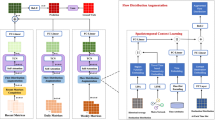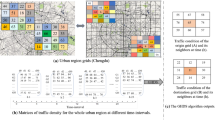Abstract
Origin-Destination (OD) prediction which aims to predict the number of passenger’s travel demands from one region to another, is critically important to many real applications including intelligent transportation systems and public safety. The challenges of this problem lie in both the dynamic patterns of the human mobility data and data sparsity in issue in some regions. Thus it is difficult to model the complex spatio-temporal correlations of the human mobility data to predict the OD of their trips. Meanwhile, the crowd flows in different regions of a city and the context features (e.g. holiday, weather and POIs) are potentially useful to alleviate the data sparsity issue and improve the OD prediction, but are largely ignored by existing works. In this paper, we propose a deep spatio-temporal framework which named Auxiliary-tasks Enhanced Spatio-Temporal Network (AEST) to more effectively address the OD prediction problem. AEST trains a model to conduct OD inference via learning crowd flow and external data as auxiliary task. The novel Hierarchical Convolutional LSTM (HC-LSTM) Network is proposed which combines CNN, GCN and LSTM to effectively capture spatiao-temporal correlations. In addition, we design a Contextual Network (ContextNet) which learns representations of contextual information to assist OD prediction. We conduct extensive experiments over bike and taxicab trip datasets in New York. The results show that our method is superior to the state-of-art approaches.






Similar content being viewed by others
Explore related subjects
Discover the latest articles, news and stories from top researchers in related subjects.References
Ashok K, Ben-Akiva ME (2002) Estimation and prediction of time-dependent origin-destination flows with a stochastic mapping to path flows and link flows. Trans Sci 36(2):184–198
Bierlaire M, Crittin F (2004) An efficient algorithm for real-time estimation and prediction of dynamic od tables. Oper Res 52(1):116–127
Cetin M, Comert G (2006) Short-term traffic flow prediction with regime switching models. Transp Res Rec 1965(1):23–31
Chen Y, Xiao D (2009) Traffic network flow forecasting based on switching model. Control and Decision 24(8):1177–1180
Chu KF, Lam AY, Li VO (2019) Deep multi-scale convolutional lstm network for travel demand and origin-destination predictions. IEEE Transactions on Intelligent Transportation Systems
Diao Z, Wang X, Zhang D, Liu Y, Xie K, He S (2019) Dynamic spatial-temporal graph convolutional neural networks for traffic forecasting. In: Proceedings of the AAAI conference on artificial intelligence, vol 33, pp 890–897
Du B, Peng H, Wang S, Bhuiyan MZA, Wang L, Gong Q, Liu L, Li J (2020) Deep irregular convolutional residual lstm for urban traffic passenger flows prediction. IEEE Trans Intell Transp Syst 21(3):972–985. https://doi.org/10.1109/TITS.2019.2900481
He K, Zhang X, Ren S, Sun J (2016) Deep residual learning for image recognition. In: Proceedings of the IEEE conference on computer vision and pattern recognition, pp 770–778
Hochreiter S, Schmidhuber J (1997) Long short-term memory. Neural Comput 9(8):1735–1780
Ioffe S, Szegedy C (2015) Batch normalization: Accelerating deep network training by reducing internal covariate shift. arXiv:150203167
Kipf TN, Welling M (2016) Semi-supervised classification with graph convolutional networks. arXiv:160902907
Krizhevsky A, Sutskever I, Hinton GE (2012) Imagenet classification with deep convolutional neural networks. In: Advances in neural information processing systems, pp 1097–1105
Lee S, Fambro D (1999) Application of subset autoregressive integrated moving average model for short-term freeway traffic volume forecasting. Transportation Research Record: Journal of the Transportation Research Board 1678
Li Y, Yu R, Shahabi C, Liu Y (2017) Diffusion convolutional recurrent neural network: Data-driven traffic forecasting. arXiv:170701926
Lin Z, Feng J, Lu Z, Li Y, Jin D (2019) Deepstn+: Context-aware spatial-temporal neural network for crowd flow prediction in metropolis. In: Proceedings of the AAAI conference on artificial intelligence, vol 33, pp 1020–1027
Liu L, Qiu Z, Li G, Wang Q, Ouyang W, Lin L (2019) Contextualized spatial–temporal network for taxi origin-destination demand prediction. IEEE Trans Intell Transp Syst 20(10):3875–3887
Ren J, Xie Q (2017) Efficient od trip matrix prediction based on tensor decomposition. In: 2017 18Th IEEE international conference on mobile data management, MDM, IEEE, pp 180–185
Seo Y, Defferrard M, Vandergheynst P, Bresson X (2018) Structured sequence modeling with graph convolutional recurrent networks. In: International conference on neural information processing, Springer, pp 362–373
Shi X, Chen Z, Wang H, Yeung DY, Wong WK, Woo Wc (2015) Convolutional lstm network: A machine learning approach for precipitation nowcasting. In: Advances in neural information processing systems, pp 802–810
Wang S, Cao J, Chen H, Peng H, Huang Z (2020) Seqst-gan: Seq2seq generative adversarial nets for multi-step urban crowd flow prediction. ACM Transactions on Spatial Algorithms and Systems (TSAS) 6(4):1–24
Wang S, Cao J, Yu P (2020) Deep learning for spatio-temporal data mining: a survey. IEEE Trans Knowl Data Eng, pp 1–20. https://doi.org/10.1109/TKDE.2020.3025580
Wang S, Miao H, Chen H, Huang Z (2020) Multi-task adversarial spatial-temporal networks for crowd flow prediction. In: Proceedings of the 29th ACM international conference on information & knowledge management, pp 1555–1564
Wang Y, Yin H, Chen H, Wo T, Xu J, Zheng K (2019) Origin-destination matrix prediction via graph convolution: a new perspective of passenger demand modeling. In: Proceedings of the 25th ACM SIGKDD international conference on knowledge discovery & data mining, pp 1227–1235
Williams B (2001) Multivariate vehicular traffic flow prediction: Evaluation of arimax modeling. Transportation Research Record: Journal of the Transportation Research Board 1776
Yao H, Wu F, Ke J, Tang X, Jia Y, Lu S, Gong P, Ye J, Zhenhui L (2018) Deep multi-view spatial-temporal network for taxi demand prediction. In: The Thirty-Second AAAI conference on artificial intelligence
Yao H, Tang X, Wei H, Zheng G, Li Z (2019) Revisiting spatial-temporal similarity: a deep learning framework for traffic prediction. In: Proceedings of the AAAI conference on artificial intelligence, vol 33, pp 5668–5675
Yu B, Yin H, Zhu Z (2017) Spatio-temporal graph convolutional networks: A deep learning framework for traffic forecasting. arXiv:170904875
Zhang J, Zheng Y, Qi D (2017) Deep spatio-temporal residual networks for citywide crowd flows prediction. In: Proceedings of the Thirty-First AAAI conference on artificial intelligence, AAAI Press, pp 1655–1661
Zhang J, Zheng Y, Qi D (2017) Deep spatio-temporal residual networks for citywide crowd flows prediction. Proceedings of AAAI
Zhang J, Chen F, Wang Z, Liu H (2019) Short-term origin-destination forecasting in urban rail transit based on attraction degree. IEEE Access 7:133452–133462
Zhang J, Zheng Y, Sun J, Qi D (2019) Flow prediction in spatio-temporal networks based on multitask deep learning. IEEE Transactions on Knowledge and Data Engineering
Zhang Y, Wang S, Chen B, Cao J, Huang Z (2019) Trafficgan: Network-scale deep traffic prediction with generative adversarial nets. IEEE Trans Intell Transp Syst, pp 1–12. https://doi.org/10.1109/TITS.2019.2955794
Acknowledgements
This work is supported by National Key R&D Program of China (No.: 2018YFB1003900), CCF-Tencent Open Research Fund and the Fundamental Research Funds for the Central Universities (No.: NZ2020014).
Author information
Authors and Affiliations
Corresponding author
Additional information
Publisher’s note
Springer Nature remains neutral with regard to jurisdictional claims in published maps and institutional affiliations.
Rights and permissions
About this article
Cite this article
Miao, H., Fei, Y., Wang, S. et al. Deep learning based origin-destination prediction via contextual information fusion. Multimed Tools Appl 81, 12029–12045 (2022). https://doi.org/10.1007/s11042-020-10492-6
Received:
Revised:
Accepted:
Published:
Issue Date:
DOI: https://doi.org/10.1007/s11042-020-10492-6




